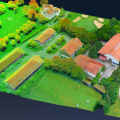
Last Friday saw the launch of NASA's Aquarius instrument, which will be used to measure the saltiness of Earth's oceans in order to advance our understanding of the global water cycle and improve climate forecasts.
A United Launch Alliance Delta II rocket carrying the Aquarius/SAC-D observatory for NASA and the Space Agency of Argentina lifted off from Space Launch Complex-2W. It was ULA's sixth launch of the year and marked the 40th Delta II launch from Vandenberg Air Force Base.
Aquarius is expected to begin delivering the most detailed map ever made of the salt content of the world’s oceans later this summer. Its three sensors can sense the equivalent of a pinch of salt in a bucket of water by bouncing microwaves off of the ocean’s surface.
The SAC-D spacecraft carrying Aquarius was built by Argentina’s space agency, CONAE. Brazil, Canada, France, and Italy also contributed to the $400 million mission.
The satellite also carries seven other cameras and sensors to monitor forest fires, search for space debris, and make measurements of sea ice.







